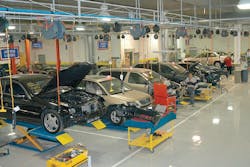In Tom Peters’ classic management text, Thriving on Chaos, he says, “Change means disruption, by definition. Whether it’s holding a welding torch at a slightly different angle, moving a file cabinet 10 feet, or installing just-in-time inventory management, change is disruptive. Constant change by everyone requires a dramatic increase in the capacity to accept disruption.”
At a recent auto body association meeting, a panel of four shop owners discussed efforts they have made to bring about greater efficiencies and profits for their businesses. In every case, this meant introducing new lean processes. Every owner had a different approach to accomplishing this, but the last panelist summed up the problem succinctly. He said getting an initial buy-in to the idea of change wasn’t that hard. At first, most employees would go along with it. But gradually, they would slip back into old, familiar habits. He said it was a constant battle to keep new processes in place.
Two of the other panelists stressed continual meetings and feedback from employees. One holds regular meetings to keep employees informed of their part in the big picture. Another panelist said they focus totally on employee “ownership” by meeting twice a day and having lean process training every 12 weeks. They set goals and project sales and post results so everyone can see where they’re at. One of the other owners said they tried offering financial rewards for change. He said they gave a monthly bonus of $100 to whoever had the most-improved working area. He said it was miraculous the way a mere $100 cleaned up the entire shop. But he admitted that when it came to wider areas of change, financial bonuses lost their effect. Like Tom Peters, everyone admitted that introducing significant change could be disruptive, and if not handled well, they could also disrupt job completions, cash flow and profits.
A few years back, Alvin Toffler, author of Future Shock, noted that studies of the effect of changes on people’s lives showed that more than one change at a time often resulted in illness. This was especially true when the loss of a job and a spouse occurred about the same time, but surprisingly it was also true when a person won the lottery and experienced a radical change in lifestyle. The implication was that there could be great wisdom in gradually introducing changes one at a time, allowing personnel to adjust to one change before introducing another.
Another way to be more certain changes will be implemented is to provide advance warning by educating people on what is coming before it arrives. Hitting personnel with unexpected changes is an almost certain way to run into resistance and disruption. A better approach can be showing the effect of change visually. One way to do this is taking technicians to a shop where changes have already been implemented to show the actual results.
A favorite place to take techs to view change was described in a FenderBender article about Keyes Collision Center (“Method Man,” March 2006), in Van Nuys, Calif. This is a spectacular 40,000-square-foot shop that had been newly created shortly before 2001. Throughout the shop, there are rows of built-in floor lifts, perfectly spaced and lined up to maximize space and ease of flow. The assembly-line structure is maintained with air hoses and electrical outlets neatly poised above each working position. Alongside each lift is a rolling task cart with all of the tools and materials a tech might need.
In a shop like Keyes, all personnel coming in require extensive training. But an existing shop introducing radical changes like these would be wise to bring them online one at a time. Otherwise the shop’s entire workflow could be disrupted, and if Toffler is right, there could be some personnel illness as well.
Tom Franklin, author of Strategies for Greater Body Shop Growth, has been a sales and marketing consultant for more than 40 years.
